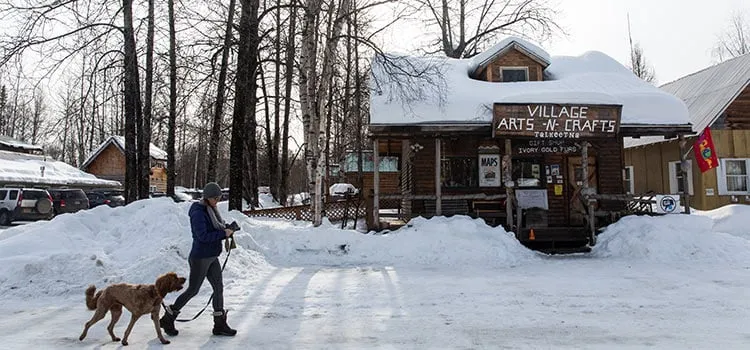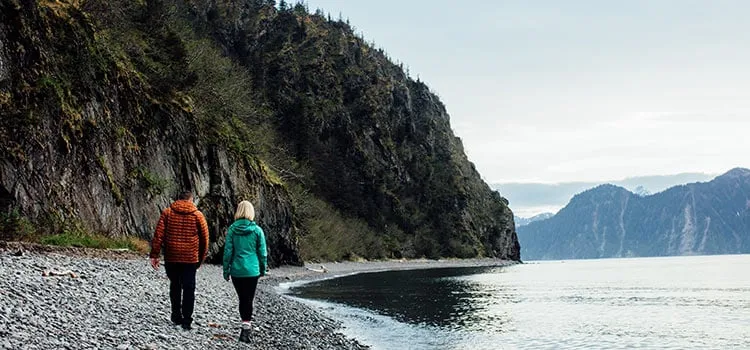Alaska, often called the Last Frontier, is a land defined by its immense scale and breathtaking natural beauty. This vastness means that describing a single “Alaska Average Temperature” is inherently complex. Unlike smaller states or countries, Alaska encompasses multiple distinct climate zones, leading to dramatic temperature variations depending on where and when you visit. Understanding these nuances is key to planning a successful and comfortable Alaskan adventure, ensuring you’re prepared for whatever weather comes your way.
Preparing appropriately for Alaska’s weather is a local mantra, often expressed as, “There’s no such thing as bad weather, just bad gear.” This highlights the importance of layering and packing for diverse conditions. Another common saying, “If you don’t like the weather, just wait 10 minutes—it’ll change,” perfectly captures the state’s unpredictable climate shifts. For instance, coastal areas like Anchorage benefit from a maritime influence, resulting in milder winters compared to the frigid interior regions like Talkeetna, where temperatures plummet significantly lower. This regional diversity makes a single “average” temperature less useful than a detailed look at seasonal and geographic variations.
Why Alaska’s Temperatures Vary So Much
The sheer size of Alaska is the primary reason behind its varied climate. Stretching from the temperate rainforests of the Southeast to the Arctic tundra of the North Slope, and encompassing vast mountain ranges and expansive interior plains, the state experiences several distinct climate types. The proximity to large bodies of water (Pacific Ocean, Arctic Ocean, Bering Sea) significantly influences coastal temperatures, making them more moderate than interior areas.
Inland regions, far from oceanic influence, experience a continental climate characterized by extreme temperature swings – very cold winters and relatively warm summers. Mountain ranges act as barriers, affecting precipitation and temperature patterns on either side. Understanding these geographical factors helps paint a clearer picture than relying on a single Alaska Average Temperature figure. Each region tells its own temperature story throughout the year.
Alaska Average Temperature by Month
While a single annual average can be misleading, looking at the Alaska Average Temperature on a monthly or seasonal basis provides much better insight. The state experiences four distinct seasons, each offering unique experiences and demanding specific preparations based on temperature expectations. Knowing what to expect month-to-month is crucial for packing and planning activities.
Winter: Embrace the Deep Freeze (December – February)
Winter in Alaska is long, cold, and often dark, especially in the northern regions. January is typically the coldest month across the state. The Alaska Average Temperature during these months can range dramatically based on location. Interior temperatures often plunge far below freezing, with averages from -15 to -1.1 °C (5 to 30 °F) being common during the day in many inhabited areas, and much colder extremes possible. Coastal areas like Southcentral see milder, though still cold, temperatures, often hovering around or slightly below freezing. This is prime time for aurora viewing and snow sports.
What to Eat in Fort Worth – A Culinary Deep Dive
Discover the Top Restaurants in Denver – A Culinary Journey
Discover Where to Visit in Las Vegas

People sitting at dining tables on a patio at sunsetThis period is characterized by heavy snowfall in many areas, creating a stunning, snow-draped landscape. While the cold is intense, the dry, crisp air and opportunities for activities like dog mushing, ice fishing, and skiing make it a magical time for those prepared. Daylight hours are very short, particularly in December, gradually increasing as spring approaches.
Spring: Thawing and Transition (March – May)
Spring is a period of significant transition in Alaska. Temperatures begin to rise, but the increase is gradual and highly variable. March can feel very much like winter, while May often brings considerably warmer weather, especially later in the month. The Alaska Average Temperature during spring fluctuates widely, reflecting the shift from frozen landscapes to thawing ground and budding vegetation.
Daytime temperatures slowly climb from below freezing averages in March into the 0-10°C (30s to 50s°F) range in April and May in many central and southern locations. This is the period of “breakup,” when ice on rivers and lakes melts, which can sometimes cause flooding but also signals the end of the deepest cold. Weather remains unpredictable, with sunshine, rain, and even late-season snow showers possible on the same day.
Summer: The Midnight Sun and Warmth (June – August)
Summer is peak season in Alaska, thanks to the warmest temperatures and the famous “Midnight Sun,” providing exceptionally long daylight hours. July is typically the warmest month statewide. The Alaska Average Temperature during summer is the most comfortable for general tourism and outdoor activities like hiking, fishing, and wildlife viewing.
Average daily temperatures in July sit around 19.4 °C (67 °F) in many populated areas. However, temperatures can reach much higher, especially in the Interior, where 32.2 °C (90 °F) is not uncommon. Coastal areas remain milder, often averaging in the mid-teens to low 20s °C (mid-60s to low 70s °F). While generally warm, summer can still bring cooler days, rain, and even snow at higher elevations, emphasizing the need for layers.
Fall: Colors and Cooling (September – November)
Fall is a brief but beautiful season in Alaska, marked by stunning autumn foliage and rapidly cooling temperatures. The weather becomes increasingly unpredictable as winter approaches. The Alaska Average Temperature drops significantly throughout the fall months, transitioning from pleasant, crisp days in September to freezing conditions by November in many areas.
September often sees average highs in the 5-15°C (40s to 50s°F) range, quickly falling to near or below freezing in October and November. This variability means you might experience sunshine, rain, fog, wind, and even snow showers, sometimes all within a few hours. Shorter days mean the Northern Lights become visible again, adding another draw for fall visitors seeking a unique Alaskan experience. Fewer crowds and potential cost savings are added benefits.
 A woman walks a dog by an arts and crafts cabin
A woman walks a dog by an arts and crafts cabin
Regional Differences in Alaska Average Temperature
Understanding the general seasonal trends is helpful, but acknowledging the significant regional variations in the Alaska Average Temperature is essential for detailed planning. The state’s vast geography dictates distinct climates in different areas.
The Interior: Extremes of Hot and Cold
The Interior region, home to Denali National Park and Fairbanks, experiences the most extreme temperature fluctuations. Summers can be quite warm, with averages reaching the 10-15.6 °C (50-60 °F) range within Denali Park during summer (though highs can hit 32.2 °C/90°F), while winters are intensely cold, with prolonged periods far below freezing. This continental climate means drier conditions compared to the coast, but temperatures are much more volatile.
Southcentral Coast: Maritime Moderation
Areas like Anchorage, Seward, and Kenai Fjords National Park benefit from a maritime climate. This influence moderates temperatures year-round. Winters are significantly milder than the Interior, with averages often hovering around freezing. Summers are pleasant but cooler than the Interior, with average highs in the mid-teens °C (mid-60s °F). This region receives more precipitation than the Interior, contributing to lush coastal forests. Higher elevations in this area, like mountains within Kenai Fjords, will naturally be colder and receive more snow.
 A couple wearing rain coats walks along the river in
A couple wearing rain coats walks along the river in
Southeast: Temperate Rainforest
The Southeast panhandle, including Juneau and Ketchikan, has a temperate rainforest climate. This means mild, wet winters (rarely dropping far below freezing) and cool, wet summers. Temperatures are the most moderate statewide, but precipitation is very high year-round. Snowfall is common in winter but often melts relatively quickly compared to other regions.
Arctic and Western Alaska: The Deep North
Regions above the Arctic Circle or along the Bering Sea coast experience true Arctic or subarctic climates. These areas have very long, intensely cold winters and short, cool summers. Average temperatures are significantly lower than in other parts of the state. Permafrost is widespread. This is the region most impacted by prolonged periods of darkness in winter and 24-hour daylight in summer.
 A woman stands on the side of a road shielding her eyes from the sun
A woman stands on the side of a road shielding her eyes from the sun
What the Average Temperature Means for Your Trip
Understanding the typical temperature ranges for your specific destination and time of visit is fundamental to planning activities and, most importantly, packing correctly. The Alaska Average Temperature in January is vastly different from the average in July, dictating entirely different types of clothing, gear, and available experiences. Cold temperatures open opportunities for ice activities and aurora viewing, while warmer temperatures are ideal for hiking, fishing, and boat tours.
Unpredictability is a constant factor. Even within a season with a relatively mild average temperature, sudden drops, wind, and precipitation can make it feel much colder. Conversely, sunny, calm days can feel warmer than the average might suggest. Being prepared for a range of conditions ensures comfort and safety, allowing you to fully enjoy the adventure without being limited by unexpected weather.
Packing for the Alaska Average Temperature
Based on the variable temperatures, the most important packing principle for Alaska is layering. Your luggage should accommodate the potential for cold, wet, and windy conditions, even in summer.
- Base Layers: Pack moisture-wicking synthetic or wool base layers (tops and bottoms) to keep sweat away from your skin. Avoid cotton, which holds moisture and makes you cold.
- Insulating Layers: Fleece jackets, down or synthetic insulated vests or jackets provide warmth. Pack multiple layers that can be added or removed easily.
- Outerwear: A waterproof and windproof jacket is essential, especially in coastal areas where rain is frequent. Waterproof pants are also highly recommended for hiking or boat tours.
- Footwear: Sturdy, waterproof hiking boots are a must for exploring. Bring extra wool or synthetic socks. For winter, insulated, waterproof boots are critical.
- Headwear and Gloves: A warm hat (wool or fleece) is crucial for retaining body heat. Gloves or mittens are needed in all but the warmest summer days, and essential in cooler seasons.
- Sun Protection: Even with cooler temperatures, the sun can be strong, especially with reflection off snow or water. Pack sunscreen and sunglasses.
- Sleeping Mask: Essential during the summer months with 24-hour daylight if you’re sensitive to light while sleeping.
Packing for the prevailing Alaska Average Temperature for your trip’s season and location, while also accounting for potential extremes and sudden shifts, will ensure you’re ready for whatever the Alaskan wilderness throws at you.
 A woman takes a picture of an orca breaching water surface
A woman takes a picture of an orca breaching water surface
Choosing the Best Time to Visit Based on Temperature
The “best” time to visit Alaska depends heavily on your desired experiences and your comfort level with different temperatures.
- For Warmth and Max Activity Options: Summer (June-August) is ideal. The Alaska Average Temperature is highest, most facilities and tours are open, and daylight is longest.
- For Northern Lights and Winter Sports: Winter (December-March) is necessary. Be prepared for very cold Alaska Average Temperature, but gain access to snow-dependent activities and aurora viewing under dark skies.
- For Fewer Crowds and Transition Scenery: Shoulder seasons (April-May, September-October) offer a balance. Temperatures are variable, but you can often find better value and experience the unique beauty of spring thaw or fall colors. Aurora viewing becomes possible again in the fall.
Ultimately, no matter when you visit, a little preparation based on the expected Alaska Average Temperature for that specific time and place will unlock the wonders of this incredible state.
Frequently Asked Questions
Understanding the Alaska Average Temperature is a common concern for visitors. Here are some answers to frequently asked questions:
Q: What is the warmest month in Alaska?
A: July is typically the warmest month across Alaska. The statewide average temperature in many populated areas is around 19.4°C (67°F), though temperatures can be significantly warmer in the interior and cooler along the coasts.
Q: What is the coldest month in Alaska?
A: January is generally the coldest month. Average daytime temperatures in January in many areas range from -15 to -1.1°C (5 to 30°F), with much colder temperatures possible, especially in the Interior.
Q: Does the Alaska Average Temperature vary much by location?
A: Yes, significantly. Due to its vast size and diverse geography, Alaska has multiple climate zones (maritime, continental, arctic). Coastal areas are more moderate, while interior regions experience extreme temperature swings between summer and winter. Temperatures also decrease with elevation.
Q: Is it always cold in Alaska?
A: No, it is not always cold. While winters are very cold, especially in the interior, summers in many parts of Alaska, particularly the interior and southcentral regions, can be quite warm, reaching into the 20s or even 30s °C (70s, 80s, and 90s °F). The perception of Alaska being always cold is a myth based on its northern latitude.
